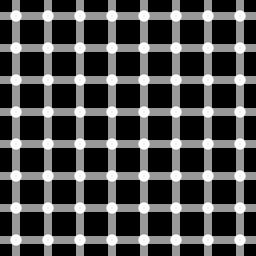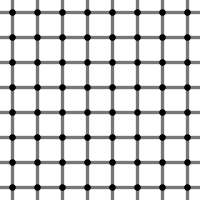Difference between revisions of "Grid illusion" - New World Encyclopedia
(Copied from wikipedia) |
(started) |
||
| Line 1: | Line 1: | ||
| − | {{Claimed}} | + | {{Claimed}}{{Started}} |
[[Category:Politics and social sciences]] | [[Category:Politics and social sciences]] | ||
[[Category:Psychology]] | [[Category:Psychology]] | ||
| + | [[Image:Hermann grid illusion.svg|thumb|256px|right|A Hermann grid illusion. Shape position and color [[contrast (vision)|contrast]] converge to produce the illusion of grey blobs at the intersections.]]A '''grid illusion''' is any kind of [[grid]] that deceives a person's vision. The two most common types of grid illusions are '''Hermann grid illusions''' and '''Scintillating grid illusions'''. | ||
| + | ==Hermann grid illusion== | ||
| + | The '''Hermann grid illusion''' is an [[optical illusion]] reported by [[Ludimar Hermann]] in 1870 while, incidentally, reading [[John Tyndall]]'s ''Sound''. The illusion is characterised by "ghostlike" grey blobs perceived at the intersections of a white (or light-colored) grid on a black background. The grey blobs disappear when looking directly at an intersection. | ||
| − | |||
| − | |||
==Scintillating grid illusion== | ==Scintillating grid illusion== | ||
| − | + | [[Image:Grid illusion.svg|thumb|256px|left|An example of the scintillating grid illusion. Dark dots seem to appear and disappear at intersections]] | |
| − | + | The '''scintillating grid illusion''' is an [[optical illusion]] discovered by E. Lingelbach in 1994, that is usually considered a variation of the Hermann grid illusion (see section below). | |
| − | |||
| − | [[Image: | ||
| − | The ''' | ||
| − | + | It is constructed by superimposing white discs on the intersections of orthogonal gray bars on a black background. Dark dots seem to appear and disappear rapidly at random intersections, hence the label “scintillating.” When a person keeps his or her eyes directly on a single intersection, the dot does not appear. The dots disappear if one is too close or too far from the image. | |
| − | + | ==Differences between the scintillating and Hermann grid illusions== | |
| + | The difference between the Hermann grid illusion and the scintillating illusion is that scintillating illusions have dots already in place at the intersection, whereas there are no dots already in place at the intersections of Hermann grid illusions. Since they are so similar, the two names are commonly used interchangeably. But the scintillating illusion does not occur with an isolated intersection, as in the case of the Hermann grid; observations suggest that a minimum of 3 × 3 evenly spaced intersections with superimposed discs are required to produce the effect. This requirement suggests the participation of global processes of the kind proposed for the linking and grouping of features in an image, in addition to local processes. | ||
| − | == | + | [[Image:White grid illusion.svg|thumb|200px|right|A white-background version of the scintillating grid illusion.]] |
| − | The | + | ==The cause of both scintillating and Hermann grid illusions== |
| + | The effect of both optical illusions is commonly (and falsely) explained by a neural process called [[lateral inhibition]]. The intensity at a point in the visual system is not simply the result of a single [[sensory receptor|receptor]], but the result of a group of receptors called a [[receptive field]]. | ||
| − | + | A [[retinal ganglion cell]] pools the inputs of several [[photoreceptors]] over an area of [[retina]], the area covered by the photoreceptors is the ganglion cells "receptive field." In the center of the receptive field the individual photoreceptors ''excite'' the ganglion cell when they detect increased luminance. The photoreceptors in the surrounding area ''inhibit'' the ganglion cell. Thus, since a point at an intersection is surrounded by more intensity than a point at the middle of a line, the intersection appears darker due to the increased inhibition. | |
| − | |||
| − | + | This explanation has recently been successfully challenged by Janos Geier (see the [http://www.michaelbach.de/ot/lum_herGridCurved/index.html interactive counter example]) using a "wavy" version of the Hermann grid in which no dots appear. | |
| − | + | ==Notes== | |
| + | <references /> | ||
==References== | ==References== | ||
| − | |||
| − | |||
| − | |||
| − | |||
| − | |||
| − | |||
| − | |||
| − | |||
==External links== | ==External links== | ||
| Line 45: | Line 37: | ||
| − | + | {{Credits|Grid_illusion|149108681|}} | |
| − | |||
| − | {{Credits|Grid_illusion| | ||
Revision as of 00:14, 6 September 2007
A grid illusion is any kind of grid that deceives a person's vision. The two most common types of grid illusions are Hermann grid illusions and Scintillating grid illusions.
Hermann grid illusion
The Hermann grid illusion is an optical illusion reported by Ludimar Hermann in 1870 while, incidentally, reading John Tyndall's Sound. The illusion is characterised by "ghostlike" grey blobs perceived at the intersections of a white (or light-colored) grid on a black background. The grey blobs disappear when looking directly at an intersection.
Scintillating grid illusion
The scintillating grid illusion is an optical illusion discovered by E. Lingelbach in 1994, that is usually considered a variation of the Hermann grid illusion (see section below).
It is constructed by superimposing white discs on the intersections of orthogonal gray bars on a black background. Dark dots seem to appear and disappear rapidly at random intersections, hence the label “scintillating.” When a person keeps his or her eyes directly on a single intersection, the dot does not appear. The dots disappear if one is too close or too far from the image.
Differences between the scintillating and Hermann grid illusions
The difference between the Hermann grid illusion and the scintillating illusion is that scintillating illusions have dots already in place at the intersection, whereas there are no dots already in place at the intersections of Hermann grid illusions. Since they are so similar, the two names are commonly used interchangeably. But the scintillating illusion does not occur with an isolated intersection, as in the case of the Hermann grid; observations suggest that a minimum of 3 × 3 evenly spaced intersections with superimposed discs are required to produce the effect. This requirement suggests the participation of global processes of the kind proposed for the linking and grouping of features in an image, in addition to local processes.
The cause of both scintillating and Hermann grid illusions
The effect of both optical illusions is commonly (and falsely) explained by a neural process called lateral inhibition. The intensity at a point in the visual system is not simply the result of a single receptor, but the result of a group of receptors called a receptive field.
A retinal ganglion cell pools the inputs of several photoreceptors over an area of retina, the area covered by the photoreceptors is the ganglion cells "receptive field." In the center of the receptive field the individual photoreceptors excite the ganglion cell when they detect increased luminance. The photoreceptors in the surrounding area inhibit the ganglion cell. Thus, since a point at an intersection is surrounded by more intensity than a point at the middle of a line, the intersection appears darker due to the increased inhibition.
This explanation has recently been successfully challenged by Janos Geier (see the interactive counter example) using a "wavy" version of the Hermann grid in which no dots appear.
Notes
ReferencesISBN links support NWE through referral fees
External links
- Refutation of classical explanation of Hermann Grid Illusion
- Scintillating Grid Illusion – Mathworld
- Giant grid
- Large Hermann Grid Illusion
Credits
New World Encyclopedia writers and editors rewrote and completed the Wikipedia article in accordance with New World Encyclopedia standards. This article abides by terms of the Creative Commons CC-by-sa 3.0 License (CC-by-sa), which may be used and disseminated with proper attribution. Credit is due under the terms of this license that can reference both the New World Encyclopedia contributors and the selfless volunteer contributors of the Wikimedia Foundation. To cite this article click here for a list of acceptable citing formats.The history of earlier contributions by wikipedians is accessible to researchers here:
The history of this article since it was imported to New World Encyclopedia:
Note: Some restrictions may apply to use of individual images which are separately licensed.

